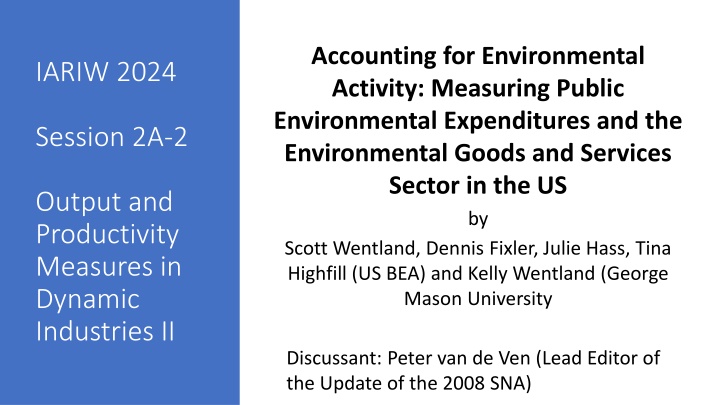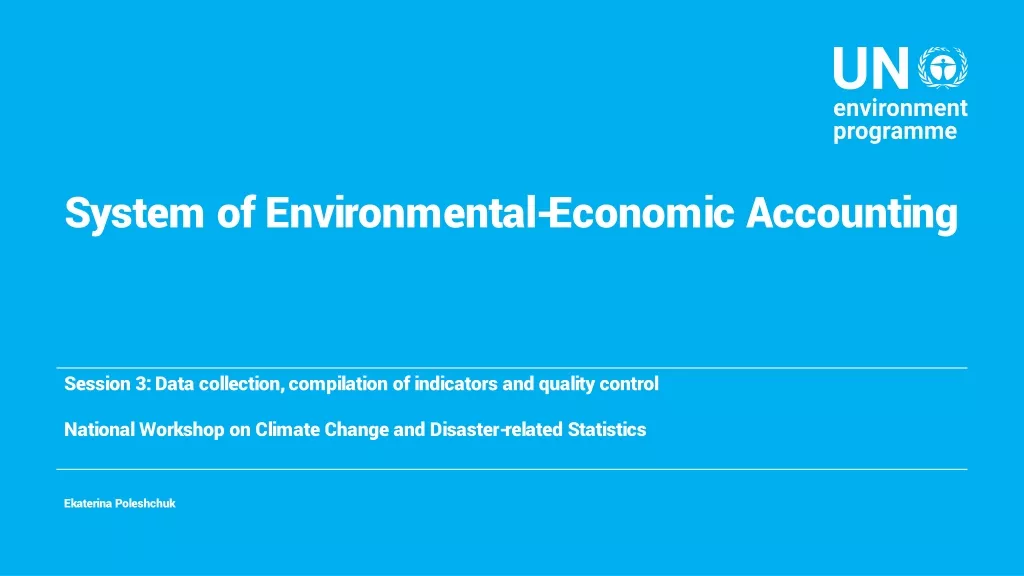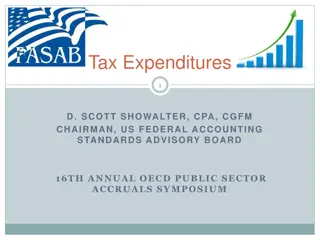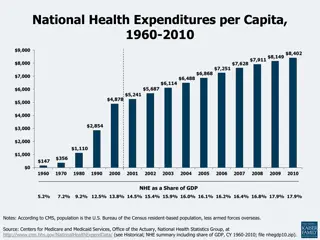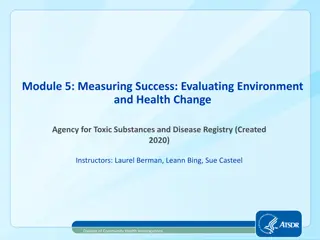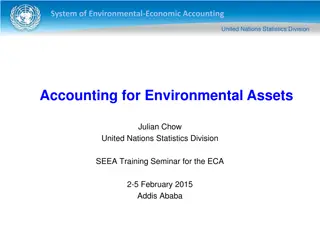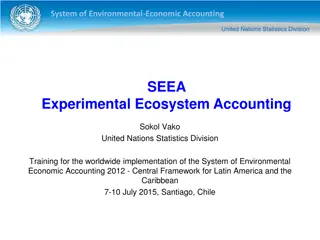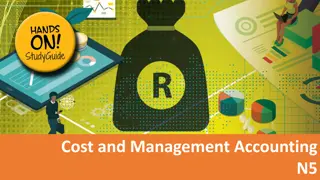Accounting for Environmental Activity: Measuring Public Expenditures
Compiling estimates on transactions in the economy related to environmental protection, resource management, and environmental goods and services sector. This research focuses on quantifying gross output across private and public sectors in 2015 and 2019, aligned with the System of Environmental-Economic Accounts (SEEA) framework.
Download Presentation

Please find below an Image/Link to download the presentation.
The content on the website is provided AS IS for your information and personal use only. It may not be sold, licensed, or shared on other websites without obtaining consent from the author.If you encounter any issues during the download, it is possible that the publisher has removed the file from their server.
You are allowed to download the files provided on this website for personal or commercial use, subject to the condition that they are used lawfully. All files are the property of their respective owners.
The content on the website is provided AS IS for your information and personal use only. It may not be sold, licensed, or shared on other websites without obtaining consent from the author.
E N D
Presentation Transcript
Accounting for Environmental Activity: Measuring Public Environmental Expenditures and the Environmental Goods and Services Sector in the US by Scott Wentland, Dennis Fixler, Julie Hass, Tina Highfill (US BEA) and Kelly Wentland (George Mason University IARIW 2024 Session 2A-2 Output and Productivity Measures in Dynamic Industries II Discussant: Peter van de Ven (Lead Editor of the Update of the 2008 SNA)
Compiling estimates on transactions in the economy undertaken to protect, rehabilitate, or preserve the environment: environmental protection expenditures (EPE) and resource management expenditures environmental taxes and subsidies environmental goods and services sector (EGSS) The scope of this paper concentrates on the last area, including a breakout quantifying gross output across both private and public sectors, for 2015 and 2019 Objectives of the research
Starting point: System of Environmental-Economic Accounts (SEEA) Central Framework 2012 (paragraphs 4.11 4.13): The scope of environmental activities encompasses those economic activities whose primary purpose is to reduce or eliminate pressures on the environment or to make more efficient use of natural resources. These various activities are grouped into two broad types of environmental activity: environmental protection and resource management. Environmental protection activities are those activities whose primary purpose is the prevention, reduction and elimination of pollution and other forms of degradation of the environment Resource management activities are those activities whose primary purpose is preserving and maintaining the stock of natural resources and hence safeguarding against depletion. Objectives of the research
Fits into a broader strategy of the US Government to develop natural capital accounts over the next decade or so An interagency group led by the White House s Office of Science and Technology Policy (OSTP), Office of Management and Budget (OMB), and Department of Commerce (DOC) recently released a national strategy for measuring natural capital and environmental-economic statistics, titled National Strategy to Develop Statistics for Environmental-Economic Decisions: A US System of Natural Capital Accounting and Associated Environmental- Economic Statistics This Strategy recommends the development of environmental activity accounts at the initial phase (Phase I) of a long-term plan to produce a full suite of SEEA-based environmental-economic accounts to complement the National Income and Product Account (SNA) Objectives of the research
Partnership among the US Census Bureau, Environmental Protection Agency (EPA), and the International Trade Administration (ITA) In 1998, the Census Bureau published the results from its Survey of Environmental Products and Services (SEPS) Specifically, the environmental industry was defined as the manufacture of products, performance of services and the construction of projects used, or that potentially could be used, for measuring, preventing, limiting, or correcting environmental damage to air, water, and soil Key departure from prior efforts and the SEEA-CF is the extent to which transportation is included, particularly if its primary purpose is not environmental Prior research
Bureau for Labor Statistics (BLS) launched a closely related initiative to measure the number of jobs associated with the environment, so-called green jobs , officially titled the Measuring Green Jobs Initiative , BLS collected data in the early 2010s for two reference years (2010, 2011). Three components: Green Goods and Services (GGS), Green Goods and Services occupation survey (GGS-OCC), and Green Technologies and Practices (GTP) GTP collected information on more than 35,000 business establishments on their use of green technologies and practices, defined as those that make their establishment's production processes more environmentally friendly or use fewer natural resources Prior research
Economics and Statistics Administration (ESA) of the US Department of Commerce issued a report Measuring the Green Economy in 2010 ESA s report defined green products and services as those with a predominant function of conserving energy and other natural resources, or reducing pollution providing options for both a narrow interpretation and a broad interpretation of the underlying activity Prior research
Closely examining European classifications and the products and industries in the European EGSS accounts, already in production for quite some time and fully aligned to SEEA-CF Especially helpful was the ESA 2010 report, Measuring the Green Economy , because of the extensive Appendix with lists that identified green products and services Leveraging detailed internal supply and use tables (SUT) data, drawn primarily from Census s Industry and Product data: 5,300 distinct product categories, combined with external source data where necessary Methodology of this research
In some cases, source data not available to separate relevant economic activities In order to explore how sensitive the estimates are to the exclusion of the categories which may be partially relevant, two scenarios: First scenario: exclude these activities (more conservative approach that wholly and unambiguously aligns with SEEA-CF Second scenario: estimate the environmental share as 10 percent for these activities, to give some weight to these relevant commodities that were designated as partially relevant Methodology of this research
Total EGSS output using first scenario: USD 620.6 bln (2015) and USD 724.5 bln (2019) Approximately 1.9% of total domestic output Total EGSS output using second scenario: USD 634.6 bln (2015) and USD 738.3 bln (2019 Main categories (first scenario): Waste management (> 25%) Management of water (around 17%) Wastewater management (13-14%) Protection of biodiversity and landscapes (>13%) Total of these four categories accounted for about 70% Private sector: 73% (2019) Results of this research
Results of this research
Refining estimates, by also using non- traditional source data Environmental R&D (initial research of possible source data already done) Potential of ESG-reporting by enterprises? Future work and preliminary conclusions Data gaps are considered significant, though not insurmountable Future work could expand the scope of the EGSS to incorporate other measures such GDP (value added), employment and compensation SEEA: binary in-out treatment of products?
Excellent piece of work, at a very detailed level Must have been hard and resource-intensive work Happy to see the alignment to international standards: not only important for reasons of analysis but also for providing momentum to this line of work Questions: Apart from funding, what do you consider the most important impediment for raising this work to the level of official statistics? Other findings of this research also considered relevant for the update of the SEEA-CF? Possibilities to extrapolate results to arrive at more timely results? Short discussion
Thank you for your attention!
